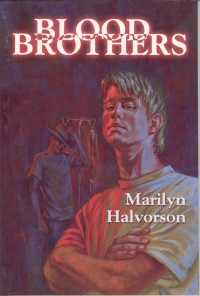| ________________
CM . . .
. Volume XI Number 11 . . . .February 4, 2005
excerpt: He said something but his voice was so low I almost didn't catch it. He gestured towards the mask. Then I got it. "Billy the Kid," he'd said, and now he added, "You look like you're about ready to rob a train." "Nope," I said. "This time I'm not stealin' from the rich, I'm givin' to the poor." Beau propped himself up on an elbow. "What are you plannin' to give to who?" Then he caught on. "You mean the stem cells?" "Yup, the vampires in the doctor suits drained me for two whole afternoons. You better take care of those little cells when you get 'em. They're used to livin' in high-class accommodation." Beau curled his lip scornfully. "Yeah, right. All that clean livin' you're so famous for. My body'll likely reject them for its own protection." "It better not," I said, dead serious now. Rejection was all too good a possibility. Marilyn Halvorson has her glass half full. In this gripping story, she reminds us all that, although life can throw you some pretty vicious curves, it can also enclose you in a circle of love that helps you face the next day. Steve Garrett, on the lam in Montana after walking away from day parole in Alberta, is called home to Fenton, Alberta, to give his 18-year-old brother Beau a bone marrow transplant to battle leukemia. With fellow worker Leroy's help, he evades his chop shop employer and the border guards and is delivered home by two sympathetic drivers. There, he is faced with the mother who left him and his father for another marriage and with his new 10-year-old sister, Jacey. Steve bottles up his anger at his mother and his fear for Beau long enough to give his bone marrow for the transplant, but he intends to leave as soon as Beau looks like he's beginning to recover. Instead, on an outing to see wild horses with Jacey, Steve finds himself chased by Romero, his former drug dealer boss whom he had turned in. Jacey masterminds an escape, and the drug dealers die in a fiery crash. Beau recovers well enough to write his exams and to attend his grad, where Steve is met by Lynne, a former girlfriend who loves him and has faith in him. Steve is the kind of character who makes teachers, police and social workers never give up on young people. Steve's story has been told in Brothers and Strangers, Stranger on the Run, and Stranger on the Line. Slowly, he seems to have overcome his anger, sense of loss, and determination to self-destruct. Unfortunately, unscrupulous characters like his chop shop boss, have taken advantage of Steve's sketchy past instead of supporting him. It is only when he realizes that his brother is dying that Steve summons the energy to break away from the crooks. He strains for patience in the face of death and begins to listen to and to observe his father and mother. Secretly delighted by his chatty, tomboyish sister, he begins to connect with the people who love him and to look forward to the future. Halvorson's secondary characters are also three dimensional and fascinating. She captures perfectly the articulate, cheery 10-year-old voice of Jacey, the hesitant fearful voice of Leroy, Pop's tired resignation and thoughtful patience, the doctor's compassion and Beau's terror. Considering Steve's past life, the plot is never unrealistic. And it never drops into melodrama, combining just the right amount of reflection and action that will attract readers from grades 8 to 11, especially boys, who will identify with Steve's more stupid moments in his past, his unquestioning support of his brother, and his anger at his mother. Clearly at home with horses and ranches, Halvorson celebrates the rural, entrepreneurial life that sweeps across Alberta (not to mention Saskatchewan and Manitoba) where rural teens will nod in recognition. Halvorson's sharp ear for dialogue brings the story alive as Beau and Steve banter and Jacey runs off at the mouth. The conversations are rural in nature, eschewing the urban jargon and swearing that often seep into older YA fiction. The dialogue does not seem cleaned up or forced, though, only witty and seamless, lightly connecting the pain of Steve's past with the possibilities for his future. Halvorson's positive look at family life and illness shows the reader that there is always hope and that families who support each other grow good people. Don't give up, she gently suggests. Those impulsive ne'er-do-wells can have a good life and just need that one more chance. Highly Recommended. Joan Marshall is the teacher-librarian at Fort Richmond Collegiate in Winnipeg, MB.
To comment
on this title or this review, send mail to cm@umanitoba.ca.
Copyright © the Manitoba Library Association. Reproduction for personal
use is permitted only if this copyright notice is maintained. Any
other reproduction is prohibited without permission.
NEXT REVIEW |
TABLE OF CONTENTS FOR THIS ISSUE
- February 4, 2005.
AUTHORS |
TITLES |
MEDIA REVIEWS |
PROFILES |
BACK ISSUES |
SEARCH |
CMARCHIVE |
HOME |
